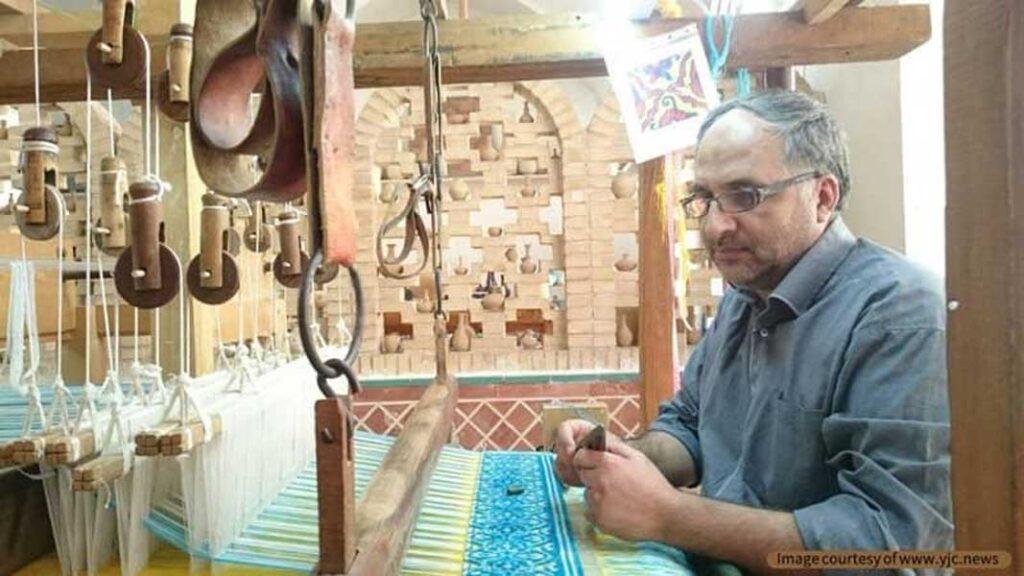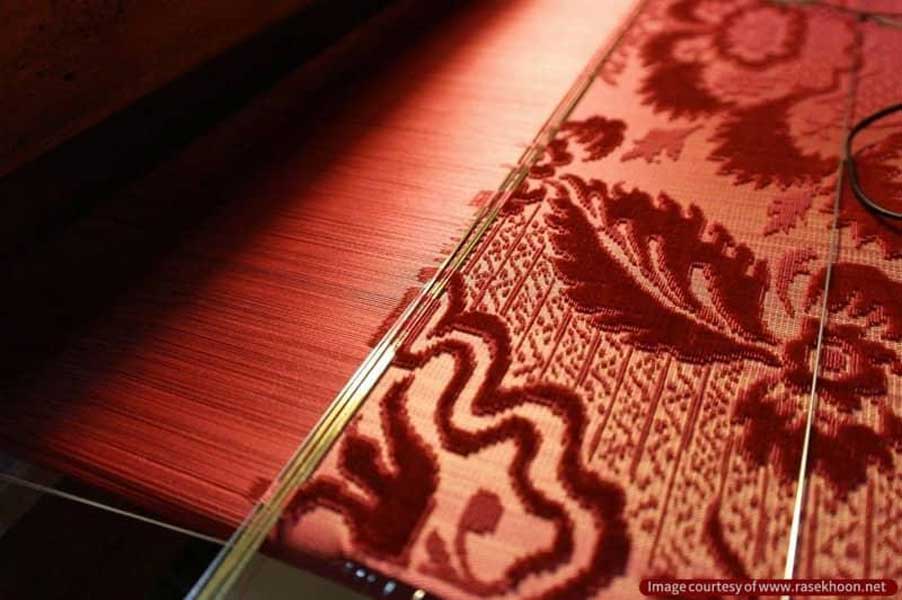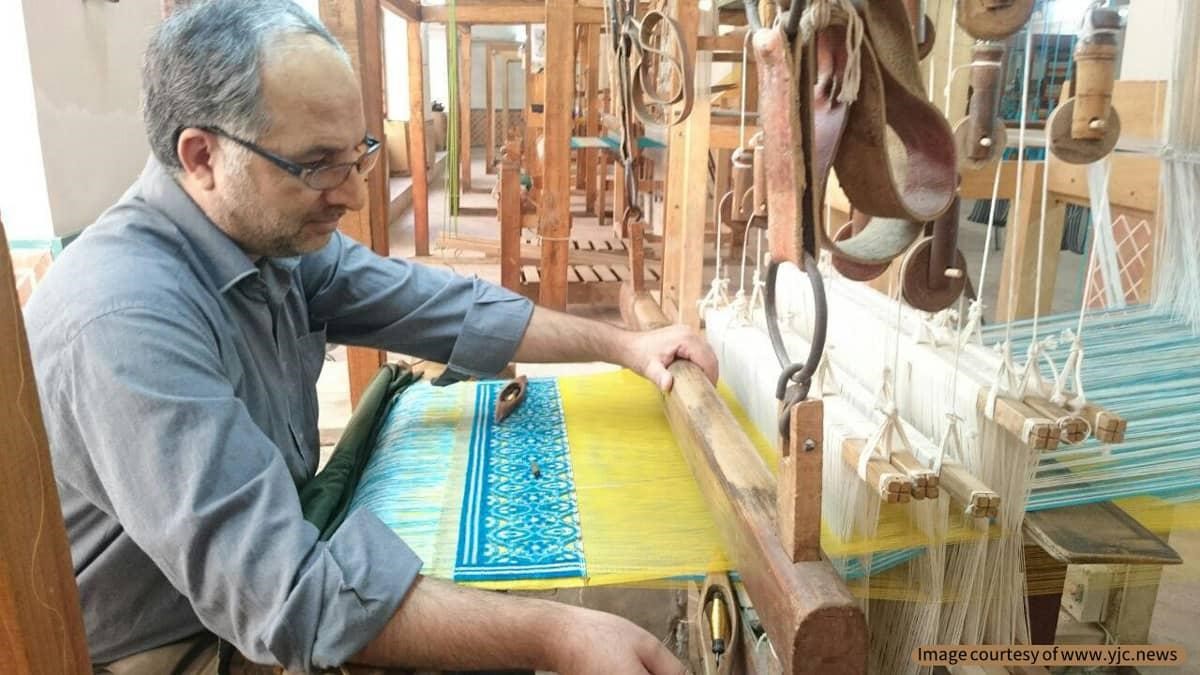
Velvet weaving in Iran has an extended history stretching back centuries. Velvet is a traditional type of silk textile and one of the famous Iran Handicrafts covered with soft and dense piles, but the backside is plain and pileless. Other threads such as cotton, linen and wool are also traditionally used to weave velvet textiles. The traditional designs on velvet textiles are embossed and impressively beautiful. In the past, this type of textile was called “Kakhma”.
History of Velvet Textile in Iran
This traditional art and craft has a long history in Iran. The advent of velvet weaving in Iran can be traced back to the 11th century AD, roughly the same time as the start of velvet weaving in China and Italy. The cities of Kashan, Yazd, Isfahan, Tabriz, Herat and Mashhad were notably famous for their role in advancing this traditional Iranian handicraft.
Velvet weaving and textile designs have undergone many developments and phases throughout history. During the Seljuk era, this craft was combined with traditional Iranian illustration and went through a phase of artistic elegance. With the arrival of the Mongols to Iran, Chinese color palettes and designs appeared in velvet weaving, but this art rose to new heights during the Safavid era.
Velvet weaving in Iran flourished during the era of the following dynasties:
Ilkhanid Era
During the Ilkhanate period, velvet weaving in Nishapur became particularly famous.
Timurid Era
During this historical period, the art of velvet weaving arrived in Kashan. Also, fluffy and low-fluff velvet fabrics were produced. Isfahan and Tabriz became landmark velvet production cities during the Timurid era.
Safavid Era
During the Safavid era, this craft received considerable attention from the royal court, which managed to establish several workshops. At this time, velvet weaving was done with gold and silver threads, and the clothes and objects produced in such fashion were considered luxurious and exquisite. Safavid kings presented these luxurious velvet clothing to European kings and elite as royal gifts.
Qajar Era
Velvet weaving remained a booming business during the reign of the Qajar dynasty. During this era, the cities of Kashan and Aran va Bidgol were more prominent centers of velvet weaving in Iran than other cities.
Pahlavi Era
The first velvet weaving factory in Iran was established during the Pahlavi era. After 1951 and the establishment of similar factories in Iran, the traditional craft was gradually replaced by industrial production.
Today, not many traditional velvet weaving workshops are left, and velvet weaving is carried out by customized weaving machinery. Velvet fabric is still used in the design of many types of clothing and object decoration, and is still considered a valuable fabric.
Traditional Velvet Weaving Loom

Traditional velvet weaving looms are small devices designed for weaving narrow pieces of fabrics or bands, used in object decoration or embellishments in traditional clothing designs, while large traditional velvet weaving looms are reserved for weaving larger pieces of fabrics and velvet rugs. Operating large velvet weaving looms is more complicated.
Today, with the large-scale production of various velvet weaving factories, traditional velvet looms are rare items and the art of traditional velvet weaving in Iran is being forgotten.
Cities Famous for Velvet Weaving in Iran
Throughout different historical periods, some Iranian cities have been famous centers of velvet weaving in Iran. Let’s go over some of the cities that are most famous for velvet weaving:
Velvet Weaving in Kashan
Kashan velvet weaving craft has retained its fame for a very long time. After the prosperity of velvet artwork in the Qajar period, it has grown more famous, but this art was first introduced to the city of Kashan during the Timurid era.
During the Qajar era, the exquisite velvet fabrics made in Kashan city were known as “Hossein Qoli Khani”. At that historical juncture, more than 42 types of traditional velvet fabrics were produced in Kashan, some of which are as follows:
- Zarbaft (gold-thread weave), Makhmal (soft velvet), Hareer (silk cloth), Atlas (satin).
In the past, velvet fabrics were used in embellishing the following objects:
- Prayer mats, Qur’an covers, coats and traditional robes, curtains, sofa covers, cushions, bedspreads, tablecloths, clothes, dowry items for brides, etc.
With the invention of industrial weaving machinery, the art of traditional velvet weaving was slowly abandoned in Kashan and traditional velvet weaving looms were replaced by industrial machines.
Velvet Weaving in Yazd
Yazd velvet weaving grew in popularity and prosperity during the Safavid era. During this historical period, Yazd was widely recognized as the center for weaving velvet fabrics. At that time, the master “Khawja Ghiyath-ud-Din Naqshband Yazdi” was a prominent master craftsman of this traditional Iranian handicraft. He taught his artistic knowledge to others and played a vital role in the development of the velvet weaving industry during the Safavid era.
After some time in Yazd, he moved to Isfahan and started practicing velvet weaving there. There are still small traditional velvet weaving workshops in Yazd today, and you can also find prosperous industrial velvet weaving factories.

Velvet Weaving in Gilan
Gilan was considered one of the important centers of sericulture and silk production due to its ideal weather conditions. This was one of the main reasons for the success of traditional velvet weaving in Gilan, but after the decline of the Safavid government, this industry met the same fate.
In fact, pest infestation lowered the survival chances of silkworms and subsequently reduced silk production in Gilan. After importing a new breed of silkworms that were resistant to pests, silk weaving in Gilan regained its lost prosperity.
Velvet Weaving in Hormozgan
The combination of Hormozgan velvet weaving with other handicrafts of this region has led to the creation of a unique practice of needlework on velvet fabrics. This is why velvet handicrafts in Hormozgan have such outlandish colors and designs.
Visit Velvet Weaving Workshops in Iran

Destination Iran is intent on promoting conscious tourism in Iran. For this purpose, we invite you to visit the overlooked traditional workshops in Iranian cities in addition to the natural and cultural attractions. Buying handicraft products from these workshops can be a small but conscious step to revive traditional handicrafts of Iran.
Frequently Asked Questions About Velvet Weaving in Iran
To find answers to your other questions, you can contact us through the comments section of this post. We will answer your questions as soon as possible.
What is velvet weaving?
The art of weaving a type of silk fabric with soft piles on one side with a plain backside is known as Makhmal Bafi or velvet weaving. Other threads such as cotton, linen and wool are also used to weave traditional velvet fabrics in Iran.
How old is the art of velvet weaving in Iran?
This type of fabric has been traced back to the 11th century. The velvets of the Seljuk period were decorated with illustrations, and during the reign of the Ilkhanid dynasty, they were influenced by Chinese designs. This traditional handicraft peaked during the Safavid era. At this time, velvet fabrics woven with gold and silver threads were presented to European kings as royal tokens.
How do they weave velvet or Kakhma?
Velvet is a fabric with fluffy texture that is woven from silk, cotton, linen or wool. This fabric is produced by attaching two layers of fabric with separate warp and wefts, which are woven together by a loom at the same time. Today, this fabric is woven in factories with advanced machines, and the traditional weaving workshops are mostly closed or about to go out of business.
How is the state of velvet weaving in Yazd province?
Velvet weaving flourished in Yazd during the Safavid era. “Khwaja Ghiyath-ud-Din Naqshband Yazdi” was one of the master craftsmen of this art. Today, small-scale traditional weaving and large-scale industrial velvet production are practiced in Yazd.
How is velvet weaving in Isfahan province today?
Velvet weaving is still popular in the cities of Aran va Bidgol and Kashan in Isfahan province. The people of Kashan have been weaving velvet since the time of the Timurids. During the Qajar period, a type of velvet fabric known as “Hossein Qolikhani” was famous, along with 42 types of velvet fabrics that were produced in the workshops of this city.














